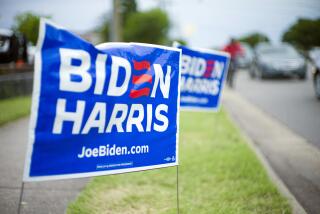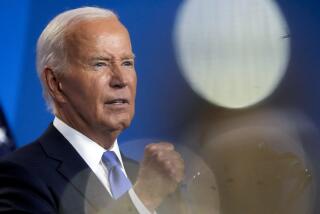When coming in second may mean a win
- Share via
DES MOINES — The top three Democratic presidential candidates have begun focusing intensely on becoming the second choice among supporters of less-popular candidates such as Sen. Joseph R. Biden Jr. and New Mexico Gov. Bill Richardson, in a behind-the-scenes battle that could decide the outcome of Thursday’s Iowa caucuses.
The effort, in which the top campaigns are deploying an array of strategies, focuses on the brief and unpredictable moment that will occur just after the first votes are cast in the state’s 1,781 caucus meetings.
Under the unusual rules of the Democratic caucuses, candidates who do not win a minimum level of support in a precinct are eliminated from consideration there, freeing their supporters to back other candidates. More than 15% of caucusgoers are thought to be backing candidates likely to be eliminated in many balloting locations -- turning their supporters into potential king-makers in the close contest among Hillary Rodham Clinton, Barack Obama and John Edwards.
The Clinton, Obama and Edwards campaigns are focusing on what their local captains should do once this large bloc of voters becomes available -- in the few moments when victory may rest on the ability to swing voters, in face-to-face appeals and cajoling, toward their second choice.
Trying to leave little to chance, Clinton’s campaign has given its local precinct captains paper cards that lay out arguments targeted to supporters of each of the candidates who might be eliminated in the first round of balloting.
Supporters of Richardson, who has called for an immediate withdrawal of U.S. troops from Iraq, are to be assured that the New York senator would end the Iraq war as well, the cards say. To win over supporters of Biden, whose most resonant strength during the campaign has been his long experience in foreign policy, the Clinton captains are instructed to emphasize Clinton’s own foreign policy experience and her desire to restore U.S. standing in world opinion.
Backers of Connecticut Sen. Christopher J. Dodd are to be told that, like him, Clinton has vast government experience.
The cards ask Clinton’s supporters to approach their second-choice targets “with kindness,” and to imagine how it would feel to have their own first choice eliminated. “Put yourself in their shoes,” read the talking points.
“It’s a lot of pressure,” said Marti Anderson, a Des Moines precinct captain for Clinton. “It’s like diplomacy. You have to find common ground.”
Obama campaign aides are preparing precinct captains with detailed lists of likely caucusgoers who have named the Illinois senator as their second choice, giving campaign volunteers the information they need to make face-to-face pitches amid the activity on caucus night.
There are signs that Edwards has the most to gain from second-choice picks, whereas Clinton may have the toughest time wooing those second-round votes.
A Los Angeles Times/Bloomberg survey of Iowa Democrats published last week showed that Edwards, the former North Carolina senator who surged four years ago to a surprising second-place finish in the caucuses, was the second choice of 23% of likely caucusgoers, compared with 20% who cited Obama as a second choice and 15% for Clinton.
Among the 13% of likely caucusgoers who planned to back Richardson or Biden, Edwards was named by a convincing plurality as the second choice.
Some strategists believe that Edwards owed his success in 2004 to the fact that he was a popular second choice in that contest, benefiting as Howard Dean and Dick Gephardt, who had been front-runners, destroyed each other’s chances with attack ads.
Edwards also benefited from a last-minute deal with Ohio Rep. Dennis J. Kucinich, a bottom-tier contender then and now, who directed his supporters to back Edwards if Kucinich was not viable in their precincts. It appears that no such deals exist now, but strategists for several campaigns said that such a move would take place only in the final hours before the caucuses.
Remarks by Clinton in a recent debate, in which she joked about an experienced governor making a good vice president, touched off speculation that Richardson may seek a pact with Clinton in hopes of securing a spot as her running mate. Both campaigns deny a deal is in the offing.
Officials from the Biden and Richardson campaigns said their primary goal was to reach viability; candidates must win support from at least 15% of caucusgoers in a precinct or be eliminated there. They said there was no plan to forge an alliance.
But the front-running campaigns are closely eyeing supporters of those campaigns -- and the supporters are eyeing the front-runners.
Gene Blanshan, a 59-year-old farmer, turned up at an Obama appearance Monday in the town of Jefferson to quiz his potential No. 2 pick.
“I’m going to give you the opportunity for your last sales pitch,” Blanshan told Obama when the microphone reached his seat. “I’m not totally undecided. I’m a Biden supporter. He might not be viable. Why should I select you over John Edwards?”
Blanshan said he had asked the same question of Edwards four months earlier, one sunny day on the courthouse steps here. The war in Iraq is his biggest concern, and he said he was looking for someone to change the path the nation is on.
Obama agreed that Biden “may not be viable,” but went on to compliment both the Delaware senator and Edwards before making the case that he could bring about more change than Edwards could.
In other speeches to voters on Monday, Obama asked explicitly: “Make me your second choice.”
Republican candidates are also engaged in a tight race for Iowa, but the GOP’s rules are far simpler, providing for just one round of voting.
On the Democratic side, campaign strategists and volunteers expect the personal appeals and interactions on caucus night to be crucial.
One Edwards precinct captain from Knoxville, Craig Kelley, recalled his frustration in 2004 when an Edwards advocate’s tone and style alienated potential supporters, prompting many to move to support John F. Kerry.
Veteran caucus participants said the fluid nature of the meetings and the quirky rules create an environment where the outcome can turn on unexpected alliances or tactical concessions.
Supporters of eliminated candidates, for example, can turn aside appeals from the surviving campaigns and form their own union, perhaps recruiting enough participants to award a delegate to a second-tier candidate.
Or, they can play the front-runners off each other: If they find themselves a few votes shy of winning a delegate, they might demand that a leading campaign send them the needed votes under the threat that they would otherwise take their entire support to a rival campaign.
A county chairwoman in eastern Iowa who plans to support Biden said she had been given no directions about what to do if her candidate does not prove viable.
“I’ll probably just go off and do my own thing, which would be to go to Edwards,” said the Biden supporter, who asked not to be identified because she does not reveal her preferences until caucus night.
At a strategy meeting just before Christmas with about a dozen other Biden precinct captains, no consensus emerged on how to proceed in a potential second round of balloting Thursday night. Some of the precinct leaders said they would try to direct caucusgoers to Obama, others to Clinton and some to Edwards.
The Biden backers also discussed joining with Dodd and Kucinich supporters to form an “uncommitted” slate. But the group came to no agreement.
One Biden campaign advisor said it was not clear yet whether the campaign would direct its volunteers on what to do if the candidate does not meet the 15% threshold.
“The first priority is to become viable,” said Paulee Lipsman, 57, a longtime Iowa political activist who is advising the Biden campaign on caucus-night strategy. But she added, “There are all kinds of scenarios that can go on over the next 48 hours.”
maria.laganga@latimes.com
Wallsten reported from Des Moines and La Ganga from Jefferson. Times staff writer James Rainey contributed to this report.
--
(BEGIN TEXT OF INFOBOX)
Back story
The Iowa caucuses, the first contests of the presidential campaign season, are closely watched in the political world as a potential early indicator of who may be the eventual Democratic and Republican nominees. They will be held Thursday.
A caucus is a group of voters that gathers in a public building, school gymnasium or private living room to discuss and advocate for a candidate.
Republicans have a relatively straightforward process of one person, one vote. On the Democratic side, it is more complicated.
To be “viable” in the Democratic caucuses -- to get enough votes to win delegates to the county conventions -- a candidate must garner the support of at least 15% of the caucus-goers present. Candidates who are “non-viable,” those receiving less than 15% of the votes, are eliminated, and their backers can switch their support to another candidate.
The competition for the votes is intense.
The three top Democratic candidates have detailed, sometimes book-length, plans to appeal to this potential pool of additional support. All sorts of forms of persuasion -- even offers to baby-sit -- are employed.
Even so, the caucuses simply select delegates that head to county conventions and are only a first step toward sending delegates to the presidential nominating conventions.
-- Nona Yates
Source: Times research
More to Read
Get the L.A. Times Politics newsletter
Deeply reported insights into legislation, politics and policy from Sacramento, Washington and beyond. In your inbox twice per week.
You may occasionally receive promotional content from the Los Angeles Times.











